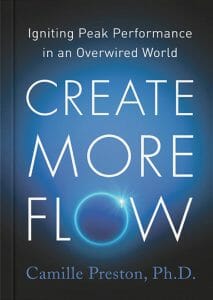
Dr. Camille Preston is the Founder and CEO of AIM Leadership and the author of Create More Flow and Rewired. A sought-after coach, speaker, and thought leader on virtual effectiveness, Dr. Preston helps individuals and organizations around the world explore how to make their work and lives more productive, pleasurable, and impactful by ensuring that technology is working for not against them. eLearningInside News recently talked to Dr. Preston about her new book and how eLearning can play a vital role in helping professionals reskill, even when they think they don’t have any time to spare for learning.
Cait Etherington: Can you tell us what you’re currently working on?

Camille Preston: In October, my second book, Create More Flow, was published, so I’ve been launching the book in several cities, which has been an amazing experience. I’m also currently doing a lot of work with clients on workplace engagement.
I know we’ve been talking about engagement for years, but guess what–our strategies to correct low workplace engagement have generally failed to have an impact. A 2017 study by Gallup found that the crisis continues to deepen. A staggering 85% of employees worldwide report they are the not engaged or disengaged at work. It goes without saying that a lot of my clients, mostly leaders of large organizations, are eager to rethink engagement. While superficial perks like ordering pizza do provide a short-term bump-up, they simply are not the answer. Investing in employees, and yes, this means investing in their training, is one proven way to tackle engagement. We are happiest when we are learning and growing, thus we feel more empowered and engaged at work. Organizations that put real money and time into training, are giving a clear message to employees that their long-term growth matters and this in turn drives up engagement
CE: But do people really have the time to focus on training? Most organizations and individuals are already stretched. How do you persuade people that training matters?
CP: I think that most people know that training matters and they enjoy it…at least, they do once they are in it! The real problem is time and more specifically, finding time to focus and stay in the learning zone.
How to create more time when time is finite? In my new book, Create More Flow, I dedicate an entire chapter to how to create more time. Here is a summary. One hack is to simply prioritize. Take a long hard look at your to-do list and then put the items in order. This sounds simple, but you’d be surprised how people don’t do this on a daily basis.
Another hack is to do a tech audit to track how many minutes are lost glancing at Facebook or Twitter or obsessively checking text messages. Most of my clients don’t realize the extent of time lost just glancing at this information channels. Maybe it’s only five or ten minutes per hour, but when it comes to training, five or ten minutes could be enough time to complete a short online module. As an added bonus, learning is also more likely to inspire and rejuvenate you than 10 minutes of Facebook.
CE: This brings me to another question. You’re a huge fan of life-long learning. Can you talk more about why this is so important?
CP: First, in today’s work world, it’s clear that reskilling is no longer an option. As automation, AI, and machine learning are scaled up, everyone’s current role is going to change drastically. So, as we enter the Fourth Industrial Revolution, training isn’t a luxury but a necessity. But training isn’t just critical for individuals who want to avoid becoming redundant. Engaging in what I like to call “purposeful struggle” is really important. Every time we throw ourselves into the unknown, learn a new skill, or encounter a new set of ideas, we’re also increasing our potential to have a powerful impact on the world. Each time we learn, we are cultivating our agility.
CE: So, how does? Can? eLearning play a role?
CP: Absolutely! When you watch a work-related video in transit or listen to a podcast at the gym or while on a run, you’re learning via electronic platforms that move with us. What’s amazing about learning online, especially in its mobile form, is that we can increasingly train on the run, sometimes literally. So, when clients tell me that they want to keep learning but don’t have the time, I first ask them to think about the small pockets of wasted time they have throughout the day. It could be their commute or the time they spend waiting for their child to finish a swimming or cello lesson or even part of their lunch break (I love podcasts while cleaning the house). I call this NET Learning (No Extra Time). I’m not suggesting that we should never take a break! Far from it, since I’m also a huge fan of release. But I do think that most of us can easily identify at least 30 minutes of time that could be put to better use. If you reclaim just 30 minutes every day for training, and still take one day off, you have just found 3 hours per week to focus on acquiring a new skill or new knowledge base, and you’re doing it in spare time that you didn’t even know existed.
I also have to add that a key part of continuing to be in the learning zone, even when you feel like your time is limited, is preparation. Ask yourself these questions: What do I want to learn? Where are the best places to access that training or knowledge? How do I make these resources easily available so I have them when I have a spare moment to focus on training? I am always asking myself these very questions and use apps, such as Wunderlist, to capture links to videos that I can watch when those moments present themselves to me. Is see all this as part of a broader question to optimize both work and training.
To learn more about AIM Leadership and Dr. Camille Preston, visit her online home.









No Comments